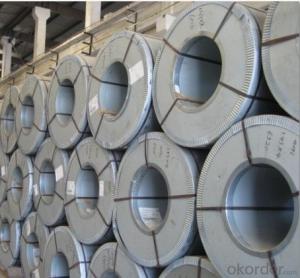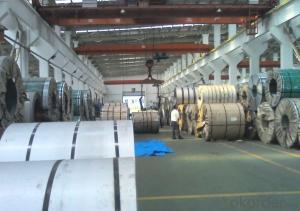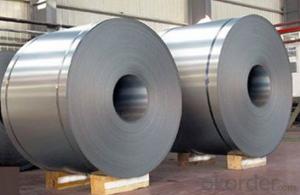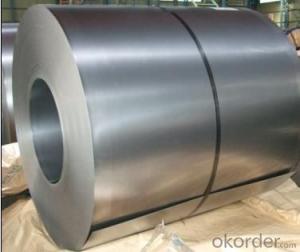Stainless Steel Coil/Sheet/Strip 304 Hot/Cold Rolled 2B/BA/NO.1
- Loading Port:
- Guangzhou
- Payment Terms:
- TT OR LC
- Min Order Qty:
- 100 m.t.
- Supply Capability:
- 20000 m.t./month
OKorder Service Pledge
OKorder Financial Service
You Might Also Like
Hot Rolled Stainless Steel Coil 304
Stainless steel is a production which not easy rust,acid resistance and corrosion resistance,so it is widely
used in light industry,heavy industry,daily necessities and the decoration industry.
Hot Rolled Stainless Steel Coil 304 Specifications
1.surface:NO.1
2.standard:JIS, AISI, GB
3.width: 0.55m, 0.65m, 1.0m, 1.22m, 1.5m, 2m or requirement
Hot Rolled Stainless Steel Coil 304 Chemical Composition:
(%):C=0.07, Mn=2.00, P=0.045, S=0.030, Si=0.075, Cr=17.5-19.5, Ni=8.0-10.5, N=0.10
Hot Rolled Stainless Steel Coil 304 Physical Properties
Tensile strength σb (MPa) ≥ 520
the conditions yield strength σ0.2 (MPa) ≥ 205,
elongation δ5 (%) ≥ 40
Reduction of ψ (%) ≥ 50,
hardness: ≤ 187
HB; ≤ 90
HRB; ≤ 200H
- Q:Are 111 stainless steel strips suitable for decorative applications?
- Indeed, decorative applications can indeed benefit from the suitability of 111 stainless steel strips. Renowned for its corrosion resistance, durability, and aesthetic charm, stainless steel has gained popularity in the realm of decorative purposes. The utilization of grade 111 stainless steel is prevalent in architectural and interior design ventures, including wall cladding, signage, furniture, and decorative trims. Its sleek and contemporary appearance, with a smooth and reflective surface, can effortlessly enhance any given area. Furthermore, the practicality of stainless steel is evident through its easy cleaning and maintenance, rendering it an ideal choice for decorative applications in both residential and commercial settings.
- Q:Can stainless steel strips be used in the production of cutlery?
- Yes, stainless steel strips can be used in the production of cutlery. Stainless steel is a popular choice for cutlery due to its durability, resistance to corrosion, and easy maintenance. Stainless steel strips can be shaped and formed into the desired cutlery shapes, providing a sturdy and long-lasting product.
- Q:Can stainless steel strips be used in the food and beverage industry?
- Yes, stainless steel strips can be used in the food and beverage industry. Stainless steel is widely used in this industry due to its corrosion resistance, durability, and hygienic properties. It is commonly used to manufacture equipment such as food processing machinery, storage tanks, conveyor systems, and brewing equipment. Stainless steel strips are versatile and can be formed into various shapes and sizes, making them suitable for a wide range of applications in the food and beverage industry.
- Q:Are stainless steel strips suitable for architectural applications?
- Yes, stainless steel strips are suitable for architectural applications. Stainless steel is a versatile and durable material that is widely used in the architectural industry for various applications. It offers excellent corrosion resistance, high strength, and an attractive appearance, making it a popular choice for both interior and exterior architectural elements. Stainless steel strips can be used in a wide range of architectural applications, including wall cladding, roofing, facades, handrails, balustrades, columns, and decorative features. They can be easily shaped, bent, and welded to create customized designs, allowing architects and designers to achieve their desired aesthetics. In addition to its aesthetic appeal, stainless steel is a low-maintenance material that is resistant to staining, scratches, and fading. It is also highly durable and can withstand harsh weather conditions, making it suitable for both indoor and outdoor applications. Furthermore, stainless steel strips are available in various finishes, including brushed, polished, and patterned, providing architects and designers with a wide range of options to choose from. This versatility allows for the integration of stainless steel strips into different architectural styles and designs. Overall, stainless steel strips are an excellent choice for architectural applications due to their durability, corrosion resistance, aesthetic appeal, and ease of customization.
- Q:What is the electrical conductivity of stainless steel strips?
- The electrical conductivity of stainless steel strips can vary depending on the specific type and composition of stainless steel. Generally, stainless steel is not as conductive as other metals like copper or aluminum. The electrical conductivity of stainless steel is typically lower due to its higher resistance to the flow of electric current. However, there are stainless steel alloys that have been specifically designed for improved electrical conductivity. These alloys often contain higher levels of elements like nickel or copper, which enhance the material's conductivity. It is important to note that the electrical conductivity of stainless steel can also be affected by factors such as temperature, surface condition, and thickness of the strip. Therefore, it is advisable to refer to specific data or consult with manufacturers for accurate information on the electrical conductivity of stainless steel strips.
- Q:What are the common uses of stainless steel strips in the pulp and paper industry?
- Stainless steel strips are widely used in the pulp and paper industry due to their exceptional properties and versatility. Here are some common uses of stainless steel strips in this industry: 1. Screens and filters: Stainless steel strips are utilized in the production of screens and filters that are used in various stages of the papermaking process. These screens and filters help to remove impurities and unwanted particles from the pulp, ensuring a high-quality end product. 2. Doctor blades: Stainless steel strips are also employed in the manufacturing of doctor blades. Doctor blades are vital components of paper machines as they scrape off excess water and chemicals from the paper during the drying process. The corrosion resistance and durability of stainless steel make it an ideal material for doctor blades, ensuring their longevity and efficient performance. 3. Rollers and shafts: Stainless steel strips are often used to create rollers and shafts that are utilized in paper machines. These rollers and shafts play a crucial role in guiding the paper through the various stages of production, such as drying, coating, and printing. Stainless steel's high strength and resistance to wear and tear make it an excellent choice for these applications. 4. Wires and mesh: Stainless steel strips are extensively used in the production of wires and mesh that are employed in paper machines. These wires and mesh help in the formation and transportation of paper fibers, ensuring proper drainage and uniformity. Stainless steel's corrosion resistance ensures that the wires and mesh remain durable and in good condition even when exposed to chemicals and moisture. 5. Pipelines and fittings: Stainless steel strips find application in the construction of pipelines and fittings used for transporting different fluids and chemicals within the pulp and paper industry. Stainless steel's resistance to corrosion and high temperatures make it a reliable choice for these applications, ensuring the safe and efficient flow of liquids throughout the production process. Overall, stainless steel strips are indispensable in the pulp and paper industry due to their durability, corrosion resistance, and versatility. From screens and filters to doctor blades and rollers, stainless steel strips play a vital role in ensuring the smooth operation and high-quality production of paper.
- Q:How do stainless steel strips handle vibration and shock?
- Stainless steel strips are known for their exceptional strength and durability, making them highly capable of handling vibration and shock. Their inherent properties, such as high tensile strength and resistance to deformation, allow them to absorb and distribute the impact forces caused by vibrations and shocks. Additionally, stainless steel's excellent corrosion resistance ensures that the strips remain intact and unaffected even in harsh environments, further enhancing their ability to withstand vibration and shock.
- Q:Can stainless steel strips be used in the textile industry?
- Yes, stainless steel strips can be used in the textile industry. They are often used in textile machinery for various purposes such as guiding, conveying, and cutting fabrics. Stainless steel strips offer durability, resistance to corrosion, and high strength, making them suitable for various applications in the textile industry.
- Q:Are stainless steel strips suitable for brewery tanks?
- Indeed, brewery tanks find stainless steel strips to be incredibly suitable. Given its outstanding corrosion resistance, durability, and hygienic qualities, stainless steel remains a favored option for brewery equipment. By utilizing stainless steel strips, the tanks are safeguarded against rust, staining, and chemical reactions, rendering them exceptionally well-suited for beer storage and fermentation. Moreover, stainless steel's ease of cleaning is paramount in preserving the beer's quality and flavor. Consequently, incorporating stainless steel strips in brewery tanks emerges as a dependable and pragmatic decision for the brewing industry.
- Q:How do you join stainless steel strips together?
- Stainless steel strips can be joined together using various methods such as welding, soldering, or using mechanical fasteners such as screws or bolts. Welding is the most common and effective method, which involves melting the edges of the strips together to create a strong bond. Additionally, soldering can be used for thinner strips, where a filler metal is melted between the strips to join them. Mechanical fasteners provide a non-permanent solution and can be used when disassembly might be required.
1. Manufacturer Overview |
|
|---|---|
| Location | |
| Year Established | |
| Annual Output Value | |
| Main Markets | |
| Company Certifications | |
2. Manufacturer Certificates |
|
|---|---|
| a) Certification Name | |
| Range | |
| Reference | |
| Validity Period | |
3. Manufacturer Capability |
|
|---|---|
| a)Trade Capacity | |
| Nearest Port | |
| Export Percentage | |
| No.of Employees in Trade Department | |
| Language Spoken: | |
| b)Factory Information | |
| Factory Size: | |
| No. of Production Lines | |
| Contract Manufacturing | |
| Product Price Range | |
Send your message to us
Stainless Steel Coil/Sheet/Strip 304 Hot/Cold Rolled 2B/BA/NO.1
- Loading Port:
- Guangzhou
- Payment Terms:
- TT OR LC
- Min Order Qty:
- 100 m.t.
- Supply Capability:
- 20000 m.t./month
OKorder Service Pledge
OKorder Financial Service
Similar products
New products
Hot products
Related keywords





























